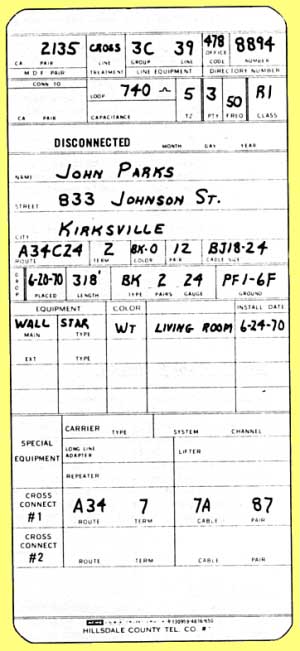H
|
PTY - FREQ,
this
space is to display the ringer frequency and the party number which stands
for frequency |
| J |
CLASS, place the
class of service this subscriber is being served as. |
K
|
DISCONNECTED, when
this subscriber is disconnected, place the date in this space and place
this card in a disconnect file, leaving all information on this card. |
| L |
NUMBER-STREET-CITY,
Place the subscriber's name and address here. |
M
|
ROUTE, Place the
plant record route number here. The terminal number on that route is placed
just after that. |
| N
|
COLOR-PAIR-CABLE SIZE,
in this space record the type, size and gauge of distribution cable this
subscriber is served by, also actual pair number in that sheath and showing
what color it is. |
| P
|
DROP, on this line
is space to record all information that may be needed in the future on
this station. It is the intent at this time that this card is a permanent
record of one service point at one address. |
Q
|
EQUIPMENT-COLOR-INSTALL
DATE, this
space can record all of the equipment used by the subscriber and shows
where it is used. Leaving this information on the card aids in servicing
a new subscriber. If the equipment is removed when the subscriber discontinues
service, just cross out the recorded units so as the information is not
lost. |
R
|
SPECIAL EQUIPMENT, Any
special equipment used along the line to make the subscribers service possible
is recorded here. Attention is brought to this section of the card by placing
a note at the top of the card in the "Line Treatment" space. |
S
|
CROSS CONNECT, this
space is to record any cross-connections made along the route to the subscriber
from the central office. Record first the location of the cross-connect
and then the new cable count pair is labeled in the cable sheath. |
T
|
ADDED SPACE, is
available at the bottom for any other information which may be required
to be recorded. |
U
|
REVERSE SIDE, of
this card has space provide to record the history of trouble that this
station may have had. This record can aid in locating any future trouble
which may be encountered. |

